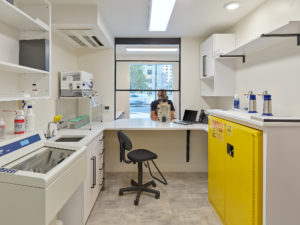- DermofPhilly
- August 5, 2022
- 7:38 am
It’s time for your annual skin check. You put on your very fashion-forward medical gown, get cozy in a fancy rocket-ship-style surgical chair, and wait for your doctor to knock on the door. Your skin exam goes well, but there’s one spot that your dermatologist takes a second look at. She’s not too worried about it, but it might be best to biopsy that changing mole just to be safe. What happens now?
What is a skin biopsy?
Your doctor can utilize a few techniques to take a piece of your skin to be tested. The two most common techniques are a shave biopsy and a punch biopsy.
A shave biopsy is a technique that is used to sample a superficial part of the skin by using a razor blade-like tool to “shave” off that top portion.
A punch biopsy is an alternative technique that uses a special tool called a “punch” to take out a circular piece of skin. This technique allows for a deeper sample to be taken compared to a shave biopsy. Since the sample is deeper, this technique typically requires a suture or two to be placed to close the skin.
The typical skin biopsy process:
- Skin cleansing – the area of your skin that will be biopsied is cleansed with an antiseptic, such as isopropyl alcohol.
- Skin numbing – the area of your skin that will be biopsied is anesthetized using a local anesthetic (usually lidocaine) that is introduced through a small needle. It only takes about 30 seconds for the anesthetic to take effect. You will not feel anything uncomfortable after the numbing is completed. (We promise!)
- Biopsy – either a shaving tool or a punch tool is used to remove your skin spot. If a shaving tool is used, a medication called aluminum chloride can be applied to stop any minimal bleeding from the cut in your skin. If a punch tool is used, your doctor will place some small stitches to close the skin back up.
- Testing – the piece of skin is placed into a specimen bottle that is sent off to a pathology lab. Here it is prepared and looked at under the microscope by a board-certified dermatopathologist.
- Results – You should receive a call from your doctor with the results in about 2 weeks.
Skin biopsies are very routine, small procedures that patients tolerate very well. They usually don’t take more than 5 minutes. You can typically return to normal activities once you leave the office.
Hopefully this helps alleviate any concerns you may have going into your appointment. If you have any more questions regarding the biopsy process you can always ask one of our knowledgeable staff members!
If you think you have a skin spot that needs to be looked at, or you simply want to book your yearly skin exam, schedule an appointment online here.



